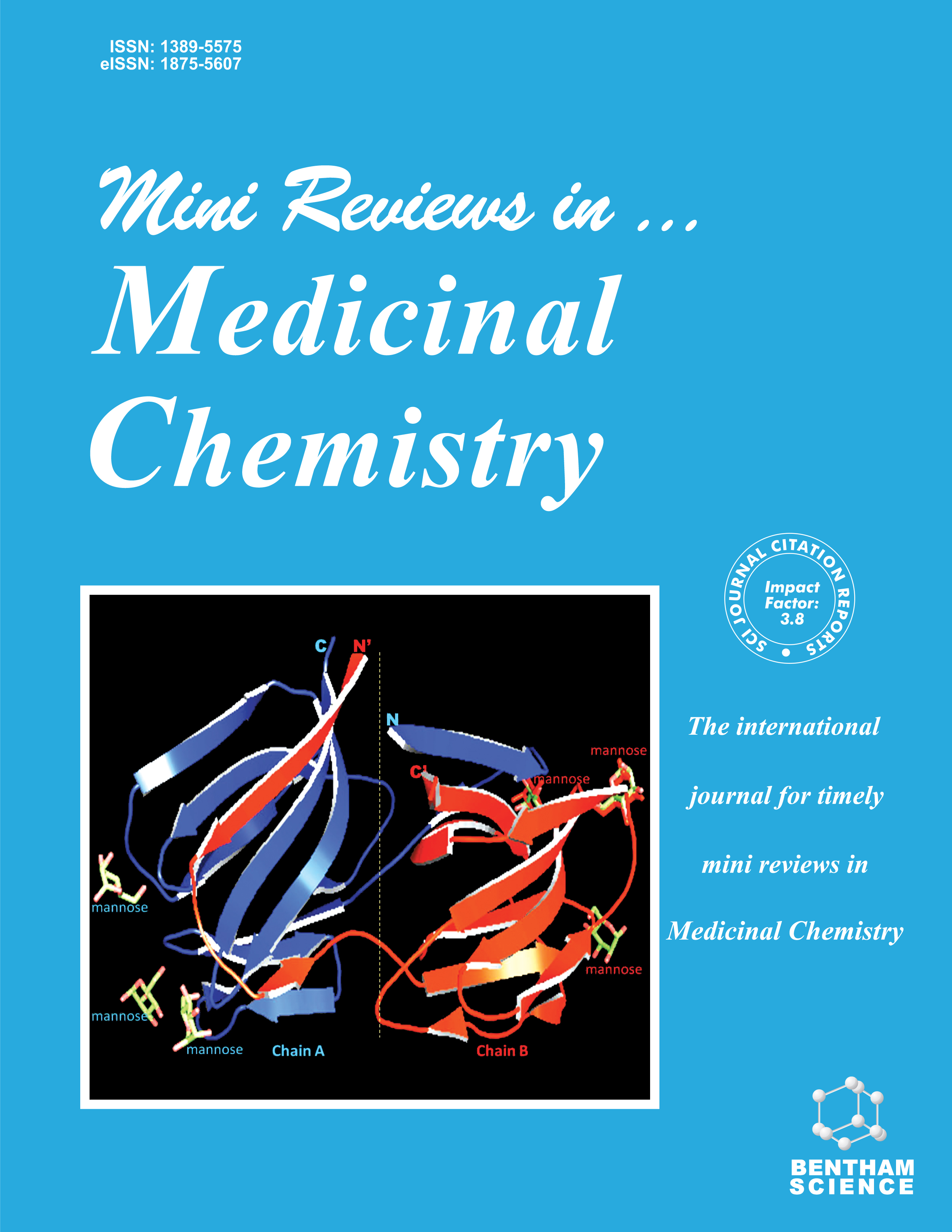- Home
- A-Z Publications
- Mini Reviews in Medicinal Chemistry
- Previous Issues
- Volume 7, Issue 6, 2007
Mini Reviews in Medicinal Chemistry - Volume 7, Issue 6, 2007
Volume 7, Issue 6, 2007
-
-
Allosteric Enhancers for A1 Adenosine Receptor
More LessAllosteric enhancers at the adenosine A1 receptor have received attention as anti-arrhythmic cardiac agents, and, more recently, as anti-lipolytic agents. In addition, allosteric modulators at the adenosine A1 receptor have therapeutic potential as analgesics and neuroprotective agents. In particular, the compounds with improved potency as enhancers and reduced antagonist properties are mentioned.
-
-
-
Natural Peroxy Anticancer Agents
More LessAuthors: Valery M. Dembitsky, Tatyana A. Gloriozova and Vladimir V. PoroikovPresent review describes research on novel natural anticancer agents isolated from terrestrial and marine sources. More than 120 cytotoxic anticancer compounds have shown confirmed activity in vitro tumor cell lines bioassay and are of current interest to Natural Cancer Institute for further in vivo evaluation. Intensive searches for new classes of pharmacologically potent agents produced by terrestrial and marine org Read More
-
-
-
New Perspectives in the Management of Secondary Hyperparathyroidism
More LessAuthors: Francesco Locatelli, Monica Limardo and Giuseppe PontorieroThe traditional treatment of secondary hyperparathyroidism, which affects many patients with chronic kidney disease and is associated with an increased risk of morbidity and mortality, is not very effective. Recent approaches to its management include the use of vitamin D analogues, non-calcium non-aluminium containing phosphate binders, and calcimimetics.
-
-
-
Back to the Future: COX-2 Inhibitors for Chemoprevention and Cancer Therapy
More LessAuthors: Fazlul H. Sarkar, Shreelekha Adsule, Yiwei Li and Subhash PadhyeFor more than a century, inhibition of prostaglandin biosynthesis via inhibition of the fatty acid cyclooxygenase (COX) has been achieved by non-steroidal anti-inflammatory drugs (NSAIDs), which targets both COX-1 and COX-2 and as such could be responsible for causing gastrointestinal (GI) toxicity. COX-2 is an inducible enzyme produced by many cell types in response to multiple stimuli. Recently, COX-2 over-expression has Read More
-
-
-
A Search for Inhibitors of S100B, a Member of the S100 Family of Calcium-Binding Proteins
More LessAuthors: Joseph Markowitz, Alexander D. MacKerell and David J. WeberTypically, malignant melanoma has wild-type p53, and yet this cancer proliferates. S100B, which binds p53 and is up-regulated in melanoma, down-regulates wild-type p53 tumor suppressor function. Inhibitors of the S100B-p53 interaction were identified using computer aided drug design (CADD) combined with NMR methodologies and represent potentially new chemotherapeutics for melanoma.
-
-
-
New Opportunities for Pregnane X Receptor (PXR) Targeting in Drug Development. Lessons from Enantio- and Species-Specific PXR Ligands Identified from A Discovery Library of Amino Acid Analogues
More LessAuthors: Peter Wipf, Haibiao Gong, Jelena M. Janjic, Song Li, Billy W. Day and Wen XieNuclear hormone receptors (NHRs) are transcription factors that bind to lipophilic signaling molecules (ligands), and subsequently regulate the expression of target genes. Since NHR ligands have potential as therapeutic agents, one of the most active research areas in the NHR field is the synthesis and identification of small molecule ligands for NHRs. Wipf et al. have recently reported the creation of a discovery library usin Read More
-
-
-
DNA Intercalators in Cancer Therapy: Organic and Inorganic Drugs and Their Spectroscopic Tools of Analysis
More LessAuthors: Nial J. Wheate, Craig R. Brodie, J. Grant Collins, Sharon Kemp and Janice R. Aldrich-WrightSince the discovery of the DNA intercalation process by Lerman in 1961 thousands of organic, inorganic octahedral (particularly ruthenium(II) and rhodium(III)) and square-planar (particularly platinum(II)) compounds have been developed as potential anticancer agents and diagnostic agents. The design and synthesis of new drugs is focused on bisintercalators which have two intercalating groups linked via a variety of ligands, Read More
-
-
-
Angiogenesis and Metastasis Inhibitors for the Treatment of Malignant Melanoma
More LessAuthors: Riichiro Abe, Yasuyuki Fujita and Sho-ichi YamagishiMalignant melanoma is one of the most highly invasive and metastatic tumors. Melanoma is an increasingly common malignancy as well, and its mortality rates have been rapidly increasing above those of any other cancer in recent years. Surgical resection and systemic chemotherapy are the main therapeutic strategies for the treatment of malignant melanoma. However, these approaches are insufficiently effective and Read More
-
Volumes & issues
-
Volume 25 (2025)
-
Volume 24 (2024)
-
Volume 23 (2023)
-
Volume 22 (2022)
-
Volume 21 (2021)
-
Volume 20 (2020)
-
Volume 19 (2019)
-
Volume 18 (2018)
-
Volume 17 (2017)
-
Volume 16 (2016)
-
Volume 15 (2015)
-
Volume 14 (2014)
-
Volume 13 (2013)
-
Volume 12 (2012)
-
Volume 11 (2011)
-
Volume 10 (2010)
-
Volume 9 (2009)
-
Volume 8 (2008)
-
Volume 7 (2007)
-
Volume 6 (2006)
-
Volume 5 (2005)
-
Volume 4 (2004)
-
Volume 3 (2003)
-
Volume 2 (2002)
-
Volume 1 (2001)
Most Read This Month
Article
content/journals/mrmc
Journal
10
5
false
en


